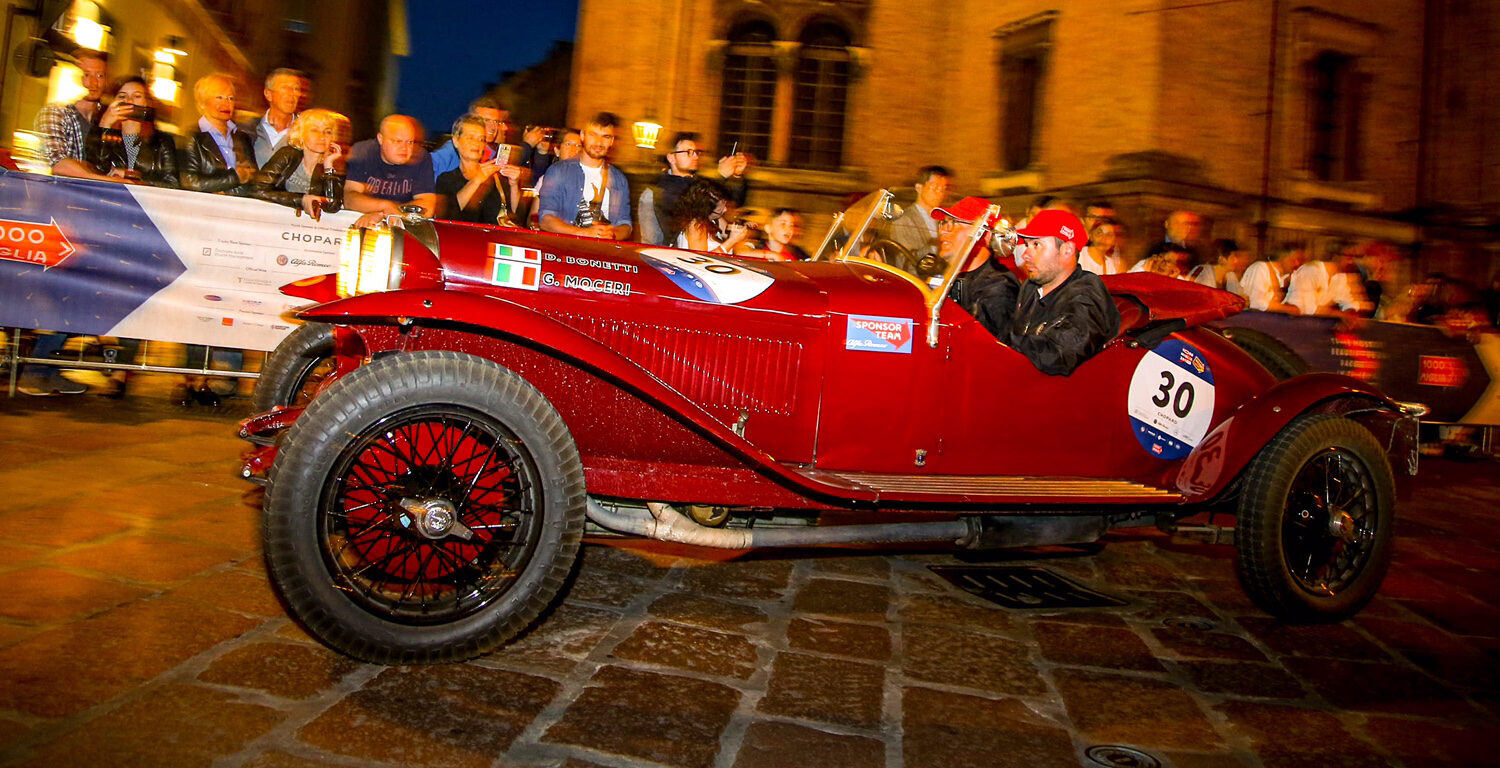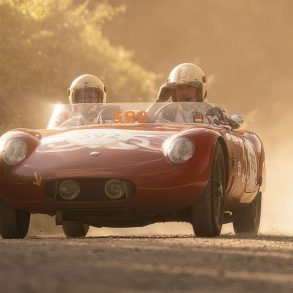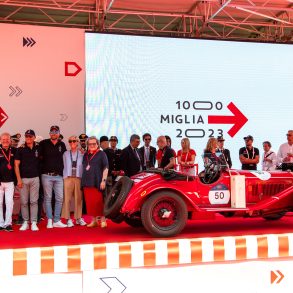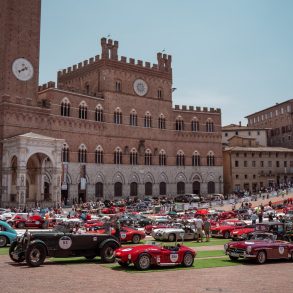With flashing precision, my memory recaptures exactly the milli-second that motor racing entered my life. It was reading a three-month-old account of the 1953 Mille Miglia in a copy of Motor Trend.
In 1953, all the new Alfa Romeo 6C 3000 CMs had led the 1000-mile thrash round Italy, and after Kling had retired, proving the old adage that “he who leads at Rome never wins the Mille Miglia” to be true, Fangio had pushed his Alfa….the Disco Volante…into the lead. Fangio was flying until he came into one of the control stops with a broken right steering arm and with 200 miles to go, dashed on with only one wheel steering to try to hold the lead.
Fangio didn’t, but he provided the moment that permeated at least one level of my consciousness forever and eventually led me to fulfill my lifelong ambition of running in the Mille Miglia.
Puccini or Verdi could have written the Mille Miglia opera, but they wouldn’t have the imagination to produce scripts that matched up to the reality. What about the very last of the “real” Mille Miglias in 1957? The beautiful Linda Christian kisses the dashing Spanish nobleman Alfonso de Portago (aka, the Marquis de Portago), waves him off, and as he fights for the lead in his blood red Ferrari, he crashes to his death and takes a dozen spectators with him. If that wasn’t meant for the stage…!
Every opera, especially the Italian ones, have their twisting plots, the heroes, the villians, the crowds often as the chorus supporting one or other of the main characters. The action moves around the stage and across several sets. In my case, the opera was a tragic comedy involving a 1929 Alfa Romeo 1500 SS Zagato. In the “Mille Miglia Opera” Act One, Scene One takes part in Brescia at the start, and then moves to “on the road… at night”, followed by flashes through the midnight lights of Verona right in front of the Arena…the world’s most famous open opera theatre! Amazing.
The scenes progress through Ferrara, then on through the threatening Central Appennine mountains and their towers of snow, followed by the plunge down to Rome, where the chorus surrounds the actors as they work over their tortured machines. At dawn, the return north brings the building crescendo.
For us, the final act starts gently. A steady run with no troubles and great enjoyment in day and night driving bringing us to the outskirts of Bologna, a bit over 100 miles from the finish.
Bologna is a big, old city, with a heavy volume of traffic on a Saturday afternoon. It’s a perfect set. And there’s a straightforward Italian theatrical answer to the problem of getting 360 vintage cars through such an obstacle without over-cooking them… declare the red lights green! It’s one of those scenes when the bit players continually rush past each other to simulate the action, except here it was real.
Because ours was a 1929 car, we were running near the front, probably the 30th or 40th car through. The simple expedient was to give the Mille Miglia cars the right of way, so at speeds of up to 70 mph, the old racers rushed down the broad urban avenues and were waved through the traffic lights by the local polizia and event officials. My very British owner/driver was a bit nonplussed by this very unBritish act, but there was little choice. We eased off and were rapidly overtaken by bigger, faster cars pouring into the city.
One, two, four… six sets of lights. I had my tape recorder on to capture this insane moment and had just said, “This is bloody dangerous,” and switched it off when the van next to us pulled away and left us exposed in the middle of a huge junction – a perfect target for the Fiat Tipo of a 20-year-old Italian girl who was driving through the green lights… right into us! That was it… for us, the Mille Miglia was over. Owner Bill was distraught (The car was due to go to auction in Monaco in two days’ time to provide his pension!) Now it was bent, with a twisted dumb-iron and broken leaf spring, though miraculously, the Zagato body was untouched.
Our race may have been over, but our opera was now reaching its exciting climax.
The police arrived, or swept in, as we pushed the car to the side of the road. A pleasant young policeman with some English was being helpful, as our assassin was on her mobile phone to get her lawyers, big brothers and who knows else. We needed to get the car to the finish to fix it, but that scheme was about to be interrupted by the arrival of the young policeman’s boss, a scary lady with eyes of fire and an unbridled need to be in charge. Accompanying her was a 10-inch shorter deputy with a 20-year-old perm… was it style, or just bad costuming?!
By this time, we had the gathering of a small crowd. This was the chorus. They were dancing backwards and forwards to the drama unfolding on the stage before them. There was pointing and gesticulating and several times the finger drawn across the throat to signal what was going to happen to us. To protect my overwrought co-driver, I sent him to the bar around the corner, when I saw that our opera was turning into “Taming of the Shrew…the Musical” in four acts.
As the final scene opens, lady police-person was singing a short little aria that translated as “impound the car… IMPOUND THE CAR!” when no insurance papers happened to be available. The other driver’s family arrived to plead in harmony for a vendetta, while another police crew arrived to argue with the first two, followed by the paparazzi joining in with the chorus in several verses of “someone has to pay… SOMEONE HAS TO PAY!”
There was a moment when I could not help but think this was some perverse version of Romeo and Juliet, though, of course, in our case it would be Romeo and Giulietta! But the crowd was moving in, and the faces looked grim. I sing, “You may take me to jail, but free the car,” when suddenly the crowd turns. A dark Mercedes screeches to the side of the road. From the car emerges the opera’s true hero, Costantino Franchi, the Segretario di Manifestasione… the “Boss” of the Mille Miglia Storica. The police….the Shrew…rush to accuse, but he exclaims that the insurance papers are in order. The chorus cheers, the lawyers weep, and Signor Franchi’s final gesture is to wave downstage to summon the recovery vehicle, onto which the sad, but still living Alfa Romeo is loaded. The few remaining members of the chorus watch as it disappears northwards to Brescia.
Night falls, and we sit dejectedly in the service vehicles, the closing scene as lights twinkle on the autostrada. Franchi leads us north and home, the hero has saved the fallen racers, but tragically, the battle has been lost. Oops…we have turned onto the autostrada in the wrong direction and are going south… could this be an encore performance?










